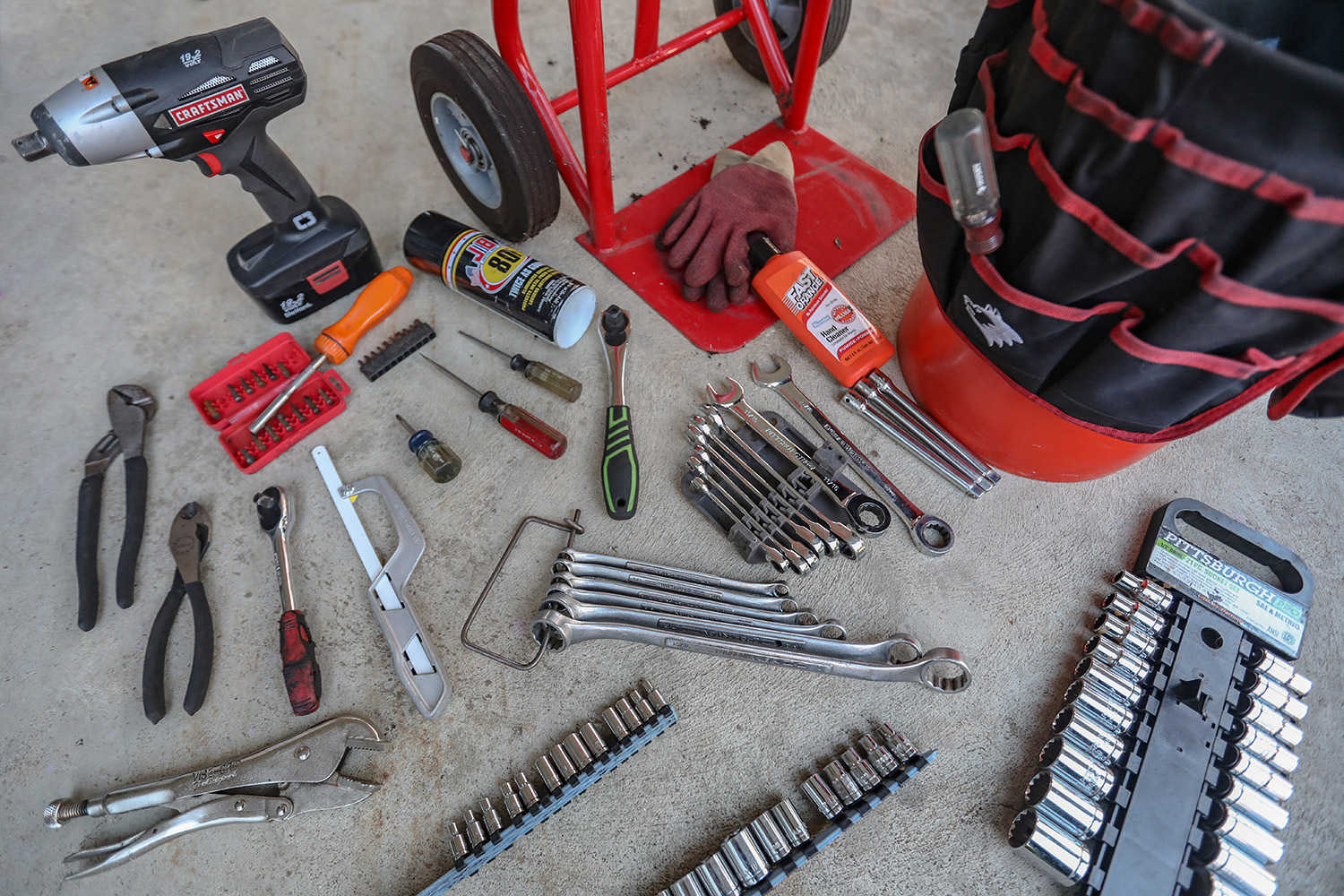Media | Articles
Must-haves for your junkyard tool kit
Whether you call it a junkyard, wrecking yard, or salvage yard, your local purveyor of you-pull-it used parts can be a great resource for much-needed bits to keep your car on the road. I’ve scored parts for my daily driver at a fraction of the dealer cost and picked parts from later-model cars that have improved my classic. A trip to the yard can often be rewarding, but without the right tools it can be a knuckle-busting experience that leaves you more frustrated than victorious.
Some veteran yard dogs go light, carrying only the tools they know they’ll need for a particular job. They are disciplined and wise. I am neither. I don’t want to go back to my truck if I see a part I want and don’t have the right tool. It would mean a long walk and I’d have to stand in line to get back in the yard. Instead I use a five-gallon bucket with a bucket organizer to hold all my tools and tote it with a hand truck. Like a boss.
Once fasteners come out of the donor car, they go in the bucket. Once the part is out, it either goes in the bottom of the bucket or on the bottom of the dolly, with the bucket on top. Tools are heavy, cast iron parts are often heavier, so I’m thankful for the dolly when making my way back to the parking lot. I can even a haul a 25-pound load of tools around without much effort.
I’m far from an expert junkyard crawler, but here’s what’s in my ready-to-scrounge tool kit. Over the years it’s served me just fine.
Sockets, ratchets, and wrenches (oh my!)
A basic SAE and metric socket set is a must-have, plus wrenches to hold the bolt on the other side or for spots where your sockets aren’t deep enough. Even if you think you know the proper sizes for your application, perhaps a newer or older version uses a different size fastener. I’ve got mostly ¼, ⅜, and ½-inch-drive sockets that cover the gamut from tiny interior and electronic studs all the way to beefy suspension components.
Marketplace
Buy and sell classics with confidence
Extensions
You may know all the tools you need to pull the part on your vehicle, but in a junkyard the same part may be found on a completely different vehicle. Having some flexibility (u-joints help) in accessing difficult fasteners can mean the difference between leaving with your parts and going home empty handed.
Breaker bar
Torque is your friend.
Hammer and pry bar
So is brute force. Tech tip: any wrench is an impact wrench if you hit it with a hammer. [Editor’s Note: While sometimes effective, this is not always the safest approach. Use at your own risk.]
Electric impact gun
Sometimes there’s no easy way to get a long breaker bar into a tight spot to exert some torque on a fastener, that’s when an electric impact shines.
Penetrating fluid
Typically, penetrating fluid takes a while to do its job, it’s still worth a shot to help unstick frozen bolts.
Screw/Nutdrivers
Knowing your target can help narrow how much you carry in. Going for ’80s or ’90s GM parts? Might want to bring a few Torx drivers. An assortment of bits and a ratcheting driver can help you have the tool you need without a lot of bulk.
Locking Pliers
True, they are not gentle on bolt heads, but if a fastener is already rounded off they can be a godsend. You can worry about a new fastener later.
Needle-Nose Pliers
Perfect for pulling cotter pins, and delicate work where your larger pliers would mangle things.
Adjustable Pliers
For mangling things. Spring tension hose clamps are no match for these babies.
Diagonal Cutter & Hacksaw
It’s often easier to just cut fuel lines or wires and deal with the fittings later, so cutting tools can save a lot of time. If you really need to cut something substantial, a cordless reciprocating saw is the way to go, although I’ve never needed one. Yet.
Gloves
Some wrecking yards have hand wash stations near the exit. Others don’t, so either way it’s better to avoid grime in the first place. Gloves also handle abrasion better than your skin. A few pairs of nitrile gloves and a set of reusable mechanics gloves should always be at the ready.
Bottle of water/hand cleaner
It can be brutal to try to wrench outside in the summer heat, so having some drinking water handy is a life saver. Whatever you don’t drink can be used to clean up, too. With the help of some liquid hand cleaner you can avoid tracking gunk into your ride.
A small tarp
Sometimes you’ve got to crawl on your back under a car, and sometimes it’s a bit muddy. Floor mats or carpet from a nearby vehicle might be available for the task, but a tarp is cheap, compact, and if it’s always in your tool bucket it’s one less thing to scrounge for. A certain discount tool store often has coupons for a free small tarp in their flyers.
Safety glasses
Especially when climbing under vehicles where grit can fall in your face.
Penlight
A small, LED light can help you find the locations of fasteners in awkward places. Headlamps work too, but sometimes it’s tough to crane your neck at odd angles.
Specialty tools
With all of those general-purpose tools in the kit there are a few things I leave out unless I truly know I’ll need them, like a flywheel puller or ball joint puller. For knowing when to pack those, I rely on. . .
Research
When planning on pulling parts from a car or truck, particularly one you’ve never worked on before, check for videos on repairing or removing that part. You might find you need a tool you don’t have or a technique that can save time and headache. Auto parts suppliers are also handy in finding which vehicles also use the whatzit you happen to be after.
Anything you swear by that I left off my list? Feel free to let me know in the Hagerty Forums. I welcome all of your junkyard wisdom.











How about adding mechanics wire, bungee cords and a ratchet strap to the list? Never know when something needs to be held up or back while removing a part.
Excellent suggestion!